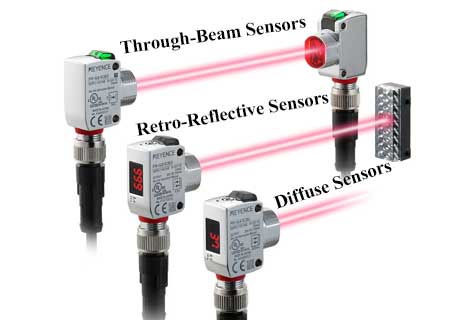How Does Photoelectric Work?
Key Takeaway
Photoelectric technology works by emitting a light beam (infrared or visible) from a transmitter, which is either reflected back from or interrupted by the target object and detected by a receiver. The sensor then converts these light changes into electrical signals to determine the presence or absence of objects.
Basic Operating Principles
Understanding how photoelectric sensors work is essential for anyone entering the field of industrial automation. At its core, the principle behind these devices is simple yet profoundly effective: they use light to detect objects. Whether it’s a piece of machinery on an assembly line or a parcel moving down a conveyor belt, photoelectric sensors can determine its presence—or absence—using a light beam. This process involves emitting light from a source, which then interacts with a target. Depending on how this light is reflected back or blocked, the sensor outputs a signal that can trigger a corresponding action.
This basic functionality makes photoelectric sensors highly versatile and invaluable in countless automated processes where precise detection and timely response are crucial.

Components and Their Roles
he typical photoelectric sensor consists of a few key components: a light emitter, a receiver, and a processing unit. The emitter sends out a beam of light—often infrared or laser—towards the target. When this light hits an object, it is reflected back in varying degrees to the receiver depending on the object’s properties and distance. The receiver’s role is to detect this reflected light and convert it into an electrical signal that the processor can use. This signal then informs the system of the object’s presence, enabling it to take appropriate action, such as stopping a conveyor or triggering an alarm.
These components work seamlessly together to provide real-time data crucial for the efficient running of automated systems.
Types of Light Sources Used
The choice of light source in a photoelectric sensor can significantly impact its effectiveness and suitability for certain environments. Common light sources include LEDs, lasers, and incandescent bulbs. LEDs are widely used for their longevity and efficiency, suitable for general purposes. Lasers, with their coherent and focused beam, are ideal for long-distance detection and applications requiring high accuracy, such as in position sensing. Incandescent lights, though less common nowadays, are sometimes used where high infrared output is beneficial.
Each type of light has its strengths and is chosen based on the specific needs of the application.
Detection Techniques Employed
Photoelectric sensors can utilize various detection techniques, primarily differentiated by how they process light interactions with targets. These include through-beam, where the light must travel from the emitter to a separate receiver without interruption; retro-reflective, which requires the light to return to the emitter after hitting a reflector; and diffuse, where the light reflects directly back from the object to the receiver in the same unit.
Choosing the right detection method depends on factors such as the environment, the nature of the objects detected, and the required range and reliability.
Practical Examples of Photoelectric Sensing
Photoelectric sensors are fundamental components in a wide range of applications, streamlining operations and enhancing user experience across various industries. For instance, in the packaging industry, these sensors play a crucial role in maintaining the efficiency and accuracy of production lines. They ensure that every package is correctly filled, sealed, and ready for shipment, preventing costly errors such as underfilled or empty packages that could lead to customer dissatisfaction and returns. This precise monitoring allows companies to uphold quality standards while optimizing resource use and minimizing waste.
In the realm of automotive manufacturing, photoelectric sensors contribute significantly to the assembly process. They are used to confirm the presence and correct placement of parts before assembly, ensuring that each vehicle meets stringent quality control standards. This is vital not only for the safety of the vehicle but also for maintaining the manufacturer’s reputation for reliability. Similarly, in public infrastructure, these sensors facilitate the automation of systems like elevators and automatic doors, improving accessibility and safety in buildings. They detect obstructions to prevent doors from closing on passersby or objects, enhancing safety and reducing liability risks.
Overall, the practical uses of photoelectric sensors are extensive and vital. They not only support industrial automation but also permeate everyday life, improving efficiency and safety in many of the technologies and facilities people rely on daily.
Conclusion
The mechanism behind photoelectric sensing is straightforward yet incredibly powerful. By harnessing the properties of light, these sensors provide critical data that drives automation in myriad industries. For newcomers to industrial automation, grasping how these devices work is a first step toward mastering the technology that keeps modern manufacturing and logistics operations running smoothly. With this knowledge, you can better understand the applications and potential of photoelectric sensors in improving both productivity and safety in automated environments.
